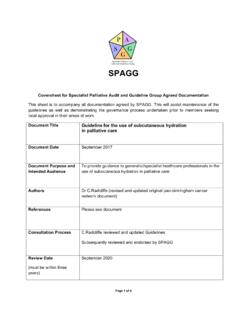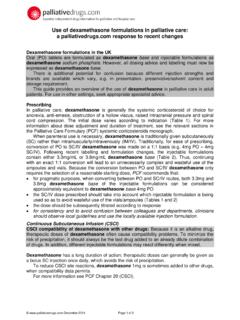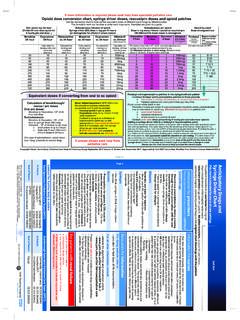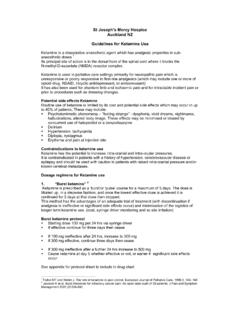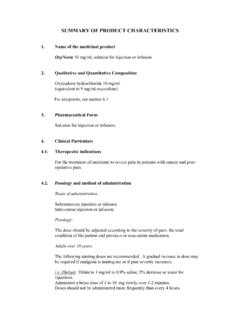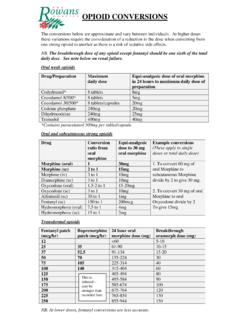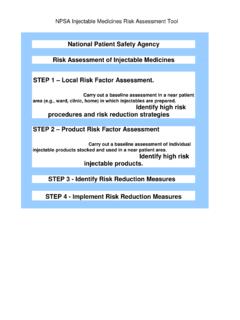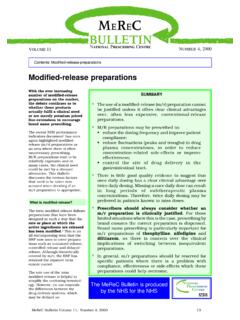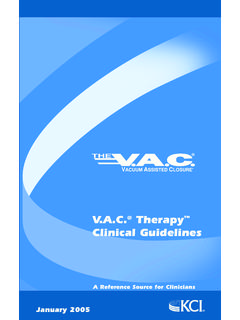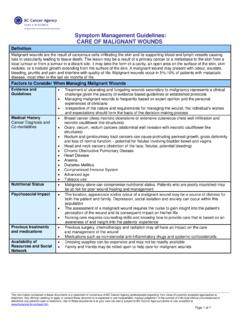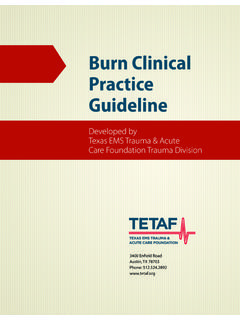Transcription of These Guidelines were originally developed for Mercy ...
1 These Guidelines were originally developed for Mercy Hospice Auckland (formerly St Joseph s Mercy Hospice), New Zealand, but demand from other palliative care providers and a substantial grant from the Genesis Oncology Trust ( ) has enabled them to be produced in this convenient and easy to read Guidelines have been independently reviewed to ensure the information presented within them is accurate and up-to-date. This review was undertaken by Jenny Phillips MA (Nursing), BSc (Hons), RGN, Nurse Practitioner ( wound care ).Copyright 2005 Mercy Hospice Auckland and Wayne NaylorDedicationTo my wonderful wife, Cheryl, who has supported me through many long days and late nights - you are my effort has been made in the writing of this document to present accurate and up-to-date information from the best and most reliable sources.
2 However, the result of managing patients wounds depends upon a variety of factors not under the control of the author. Therefore the author does not assume responsibility for, nor make any warranty with respect to, the outcomes achieved from the information described FOR wound MANAGEMENT IN PALLIATIVE care .Wayne Naylor - BSc(Hons), PG Cert (Palliative care ), Dip Nursing, Oncology cert. (ENB 237), RCompNWayne Naylor is a New Zealand registered nurse who began his career in forensic psychiatry before moving into general surgery, and then to reconstructive plastic surgery and burns. After a move to the United Kingdom, Wayne worked for the Royal Marsden NHS Trust in London, where he completed his BSc (Hons) Degree in Adult Cancer Nursing.
3 For a little over three years Wayne was employed as the wound Management Research Nurse at the Royal Marsden, a role that involved clinical patient care , research, education, and quality-assurance activities related to wound management in cancer patients. Wayne has published a number of journal articles and has contributed chapters to eight books on cancer nursing, wound management and palliative care . He was also lead editor for the Royal Marsden Hospital Handbook of wound Management in Cancer care , published in returning to NZ in 2002 Wayne worked as a Clinical Nurse Specialist at the Wellington Blood & Cancer Centre, part of Capital & Coast District Health Board s Wellington campus. In 2004 Wayne completed a Post-Graduate Certificate in Clinical Nursing (Palliative care ) at Victoria University of Wellington, and was awarded the Lady Todd Memorial Prize in Nursing and Midwifery for the work he completed during this course of study.
4 Currently, Wayne is employed as a Clinical Nurse Educator and Nurse Lecturer in Oncology and Haematology at the Wellington Blood & Cancer Centre. His special interests include cancer nursing, palliative care , wound management and men s the AuthorGUIDELINES FOR wound MANAGEMENT IN PALLIATIVE care .INTRODUCTION ..6 wound care of the of the wound Healing ..9 wound Healing Process ..9 Impediments to Healing ..11 wound Assessment ..13 wound Cleansing ..15 wound Bed Preparation ..15 MANAGING SPECIFIC WOUNDS ..18 wound care in Palliative Patients ..18 Malignant Fungating Wounds ..20 Pressure Ulcers ..25 Fistulae ..34 Radiotherapy Skin Reactions ..36 Oedema and Lymphoedema Management ..40 Managing wound Pain ..43 GUIDE TO wound DRESSINGS.
5 47 Selecting an Appropriate Dressing ..47 Index of wound Dressings / Devices ..49 Activated charcoal dressings ..49 Adhesive island dressings ..50 Alginates ..50 Burn ..52 Hydrosorbtive ..52 Honey ..53 Hydrocolloids ..53 Hydrofibre ..54 Hydrogels ..54 Hydrogel sheets ..55 Iodine dressings ..55 ContentsGUIDELINES FOR wound MANAGEMENT IN PALLIATIVE care .Low-adherent wound contact layer ..56 Metronidazole gel ..56 Non-adherent wound contact layer ..57 Paraffin gauze ..57 Semi-permeable films ..58 Silver impregnated dressings ..58 Skin barrier films ..59 Sugar paste ..59 Topical negative pressure therapy ..60 Secondary dressings ..60 Tapes / fixation ..61 REFERENCES ..62 ContentsGUIDELINES FOR wound MANAGEMENT IN PALLIATIVE care . wound management can be a challenging area of care given the continuing developments in our understanding of the process of wound healing, and the bewildering array of dressings and devices available for the treatment of wounds.
6 It is an area of care that is predominantly undertaken by nurses, who contribute a great deal to the body of knowledge on wound management through research, practice development and product wound care in a healthy person can at times be quite difficult, the situation becomes significantly more challenging in patients with life-threatening chronic disease. This situation exists in palliative care patients, who are at risk of a number of complex wounds. These wounds may arise as a direct result of their disease, a complication of their disease or as a side effect of disease modifying treatment. There are often difficult to manage symptoms associated with the wound , which in turn can lead to distressing psychological and social problems.
7 When combined with the other significant issues faced by palliative care patients, wound management for These people represents a unique challenge requiring a holistic and innovative problem solving Guidelines have been written as a means of accessing up-to-date information on wound management with a particular emphasis on the care of wounds and related symptoms experienced by palliative care patients. The Guidelines are separated into three main sections focusing on the basics of wounds care , management of specific wounds and a guide to dressing products. Ease of access and understanding have been key themes underpinning the style and layout of the Guidelines , as has the provision of information at a level that will suit all carers.
8 While the Guidelines were originally developed for use in the hospice setting, they will be applicable to palliative care patients wherever they receive FOR wound MANAGEMENT IN PALLIATIVE care .Structure of the SkinThe skin and its accessory structures make up one of the largest organs of the body called the integumentary system. It covers the entire surface of the body containing and protecting internal structures, and providing information about the external environment. Skin consists of two main layers, the epidermis and dermis, and is attached to the subcutaneous layer, which in turn is fixed to underlying muscle and bone (Tortora & Grabowski, 2002).EpidermisThe outer-most layer of the skin is the epidermis, which is in direct contact with, and provides a tough impermeable barrier to, the external environment.
9 Approximately 90% of epidermal cells are keratinocytes, the remainder are predominantly melanocytes that produce pigment, Langerhans cells that are involved in cell-mediated immune responses and Merkel cells, which are involved in touch sensation (Tortora & Grabowski, 2002; Ross, Romrell & Kaye, 1995; Strete, 1995). The cells of the epidermis are organised into four distinct cellular layers (Figure 1): Stratum corneum - the outer-most layer, which is comprised of inactive, flat keratinocytes filled with keratin. It is impermeable to water, bacteria and a number of chemicals (Tortora & Grabowski, 2002). Stratum granulosum - containing cells in various stages of degeneration. Stratum spinosum - an active layer several cells thick in which the cells are tightly bound together by cell membrane processes called desmosomes (Marieb, 2001).
10 Stratum basale - the deepest layer consisting of a single layer of cuboidal cells that divide and send new cells upwards to become part of the outer layers. The surface of hair follicles and sweat glands are also lined by the stratum basale (Ross et al, 1995).The soles and palms have an extra layer between the stratum corneum and stratum granulosum known as the stratum lucidum. It is a specialised layer designed to provide extra cushioning against surface impact (Tortora & Grabowski, 2002). The epidermis is tightly bonded to the dermis by the basement membrane, an acellular layer composed of protein fibres (Stocum, 1995).DermisThe dermis provides skin with its strength and flexibility through the combination of two strong elastic fibres, collagen and elastin, surrounded by a gel-like material composed of dermal proteoglycans (Tortora & Grabowski, 2002; Marieb, 2001).

